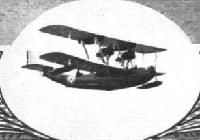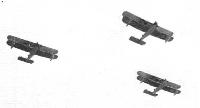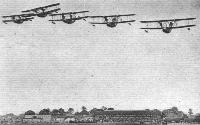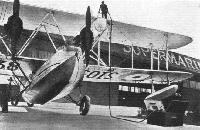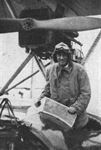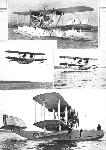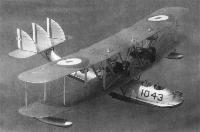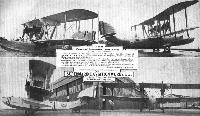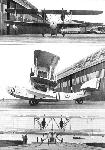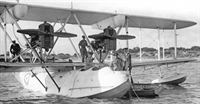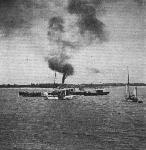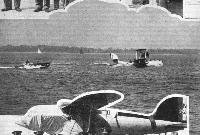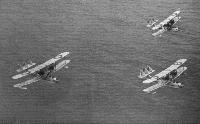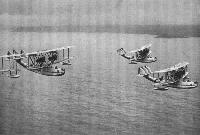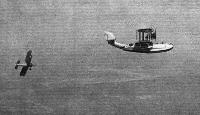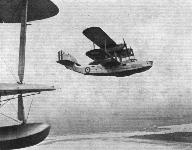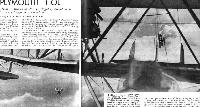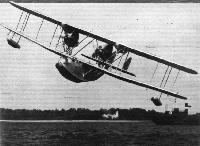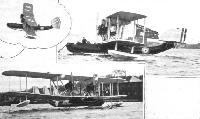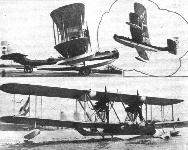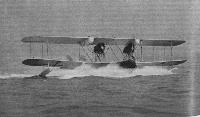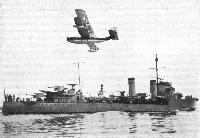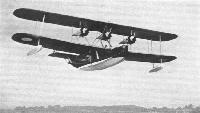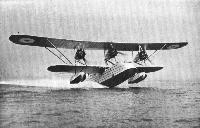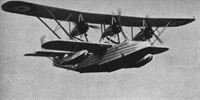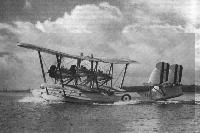
Описание
Страна : Великобритания
Год : 1925
Летающая лодка
Летающая лодка - разведчик
Варианты
- Supermarine - Swan - 1924 - Великобритания
- Supermarine - Southampton / Solent - 1925 - Великобритания
- Supermarine - Scapa - 1932 - Великобритания
- Supermarine - Stranraer - 1934 - Великобритания
Supermarine Southampton
Самолет Southampton был разработан на базе единственной 10-местной летающей лодки Swan, использовавшейся компанией "Imperial Airways", дополнявшей ее парк из трех Sea Eagle на линии Саутгемптон - Нормандские острова в 1926-1927 годах.
Конструктор Реджинальд Митчелл, создав Southampton, добился своего первого крупного успеха. Для британских ВВС было построено не менее 68 этих элегантных летающих лодок с экипажем из пяти человек.
Southampton был выполнен по схеме биплана со стабилизирующими поплавками под крылом и узким корпусом с высоко поднятой хвостовой частью, на которой было установлено горизонтальное оперение. Вертикальное оперение, установленное на горизонтальном, было трехкилевым. Силовая установка включала два ПД Napier Lion, установленных на подкосах между крыльями.
Первая из шести летающих лодок Southampton Mk I с деревянным корпусом совершила первый полет 10 марта 1925 года, а несколько месяцев спустя начались первые поставки 480-му авиазвену береговой разведки ВВС.
Основным серийным вариантом стал Southampton Mk II, на котором ввели дюралюминиевый корпус, обеспечивающий лучшие летные характеристики.
Southampton поступил на вооружение 201-й, 203-й, 204-й, 205-й и 210-й эскадрилий британских ВВС и нес службу более десятилетия. Кроме того, эти самолеты строились по заказам Аргентины (восемь) и Турции и Японии (шесть). Австралия получила два Mk 1, ранее служивших в Великобритании.
ТАКТИКО-ТЕХНИЧЕСКИЕ ХАРАКТЕРИСТИКИ
Supermarine Southampton Mk II
Тип: летающая лодка - разведчик
Силовая установка: два V-образных 12 цилиндровых ПД Napier Lion VA мощностью по 500 л. с. (373 кВт)
Летные характеристики: максимальная скорость на уровне моря 174 км/ч; потолок 4265 м; максимальная дальность полета 1497 км
Масса: пустого 4082 кг; максимальная взлетная 6895 кг
Размеры: размах крыла 22,86 м; длина 15,58 м; высота 6,82 м; площадь крыла 134,61 м2
Вооружение: три 7,7-мм пулемета Lewis (один в носовой и два в средней части корпуса) и 499 кг бомб
Описание:
- Supermarine Southampton
- Flight, November 1926
THE SUPERMARINE "SOUTHAMPTON” - Flight, July 1928
THE SUPERMARINE "SOUTHAMPTON” - Flight, July 1929
BRITISH AIRCRAFT AT OLYMPIA - Flight, November 1932
British Aircraft
Фотографии
-
Flight 1926-11 / Flight
Регистрационный номер: S1037 [2] The Supermarine "Southampton" at rest on the water.
-
Flight 1940-04 / Flight
1925 - the beginning of modernity. The first Southamptons had wooden hulls. This particular machine is the first ever built, and carried on its bows a shield presented by the town of Southampton.
-
Flight 1925-08 / Flight
THE SUPERMARINE "SOUTHAMPTON": The "Southampton," which is fitted with two Napier "Lion" engines, has now gone into quantity production, but at present no details concerning it may be published.
-
Flight 1926-11 / Flight
The Supermarine "Southampton" about to alight.
-
Aeroplane Monthly 1976-09 / C.Andrews - The Southampton saga
Регистрационный номер: N9896 [2] Capt Henri Biard takes the first production Southampton I, N9896, for its maiden flight, March 1925.
-
Aviation Historian 11 / F.Merriam - Happy but Broke /Echoes from Dawn Skies/ (6)
Регистрационный номер: N9896 [2] The first production Supermarine Southampton, N9896, made its first flight in the hands of Henri Biard on March 10, 1925. After passing its tests at the Marine Aircraft Experimental Establishment, the type was put into production, the RAF’s No 480 (Coastal Reconnaissance) Flight receiving its first examples a mere six months later.
-
Flight 1926-11 / Flight
The Supermarine "Southampton" in the air: This machine is capable of flying and manoeuvring with one of its Napier "Lion" engines stopped.
-
Flight 1925-03 / Flight
THE LATEST SUPERMARINE FLYING BOAT: The "Southampton," fitted with two Napier "Lion" engines, is of typical Supermarine lines, but has three fins and three rudders, although the horizontal tail is of monoplane type
-
Flight 1927-05 / Flight
THE HAMPSHIRE AIR PAGEANT: Event 3, Flying boat v. Land 'plane. Three Supermarine "Southampton" flew over the aerodrome
-
Flight 1929-07 / Flight
EVENT 4. FLYING-BOATS: Five Supermarine Southampton (Napier Lions) flying-boats of No. 201 Squadron flew over the aerodrome in formation. One dropped out and flew low past the Royal Enclosure, to give us a "close-up" (on the left).
-
Flight 1930-07 / Flight
The Coastal Area: Five Supermarine Southamptons from Calshot visit Hendon.
-
Aeroplane Monthly 1974-09 / ??? - Hendon Pageantry 1920-37
Perfect timing. Five Supermarine Southamptons of 201 Squadron arrive from Calshot and pass over the aircraft park at the 1930 pageant. The Royal box is in the background, on the left.
-
Flight 1926-11 / Flight
Two Supermarine "Southamptons" off Cromer: The machine in the background is alighting, while that in the foreground is already moored.
-
Flight 1927-08 / Flight
THE SERVICE SCANDINAVIAN CRUISE: The one of the four R.A.F. flying-boats which are taking part in a cruise round Scandinavia. The Supermarine "Southampton" (two Napier "Lions");
-
Flight 1929-05 / Flight
A FLYING-BOAT ON THE NORFOLK BROADS: This photograph shows a Supermarine "Southampton" which recently alighted on Oulton Broad. This is believed to have been the first time in history that a flying-boat has alighted on and started from one of the Broads. In front of the "Southampton" may be seen one of the 24-ft. Brooke 30 m.p.h. "Seacars" ordered for use by the R.A.F. in connection with the Schneider Trophy Contest.
-
Flight 1928-05 / Flight
AIR MINISTER'S CHANNEL CRUISE: This week Sir Samuel Hoare is making a cruise of (inspection to the Channel Islands, Scilly Islands, &c, in one of the new Short all-metal "Calcutta" flying boats with "Jupiter" engines. The "Calcutta" is seen at the moment of departure, while in the foreground is the Supermarine "Southampton"-Napier which is escorting the Air Minister on his cruise.
Другие самолёты на фотографии: Short Calcutta / Rangoon / S.8 - Великобритания - 1928
-
Flight 1926-12 / Flight
A Batch of Supermarine "Southamptons" at mooring off Cromer.
-
Flight 1926-08 / Flight
CRUISE OF THE "SOUTHAMPTONS": The two Supermarine flying-boats, Napier "Lion" engines, arriving at the Cattewater seaplane station, after their successful flight of nearly 7,000 miles.
-
Flight 1925-09 / Flight
THE SUPERMARINE "SOUTHAMPTON": Note the clean running of the machine, reference to which was made in the paper read by Mr. Simmonds. The engines are Napier "Lions."
-
Flight 1927-03 / Flight
Supermarine "Southampton" (Two Napier "Lion" engines). One of the remarkable facts about the "Southampton" was that it was designed and constructed in 7 1/2 months and immediately went through its official tests without a hitch, and then became a standard type to the R.A.F. Hardly were they in Service use when they undertook a cruise round the British Isles, and were officially praised for their performance. The "Southampton" carries no petrol in the hull, the main tanks being supported under the top 'planes, which gives unusual freedom for the crew in the hull, and even space to sling hammocks. Attached to Coastal Area.
-
Flight 1926-11 / Flight
THE SUPERMARINE "SOUTHAMPTON": Three-quarter front view of the machine on the slipway. This photograph also gives a good idea of the somewhat unusual arrangement of the interplane struts. The Napier "Lion" engines are mounted on struts independent of the wing structure and can be removed without interfering with the wing bracing.
-
Flight 1929-10 / Flight
Регистрационный номер: S1038 A Supermarine Southampton filling up from the new Bowser pit at Hythe.
-
Flight 1926-11 / Flight
Fuelling a Supermarine "Southampton" in front of the works.
-
Flight 1934-03 / Flight
ON THE SLIPWAY: Airmen are receiving instruction in mooring tackle.
-
Flight 1940-04 / Flight
THIRTEEN YEARS AGO. In 1927 a number of British flying boats paid a visit to Scandinavia. They included a Supermarine Southampton, and this photograph shows Sir Samuel Hoare, Air Minister then as now, in the Southampton in which he returned from Copenhagen.
-
Flight 1927-05 / Flight
Регистрационный номер: N218 [2] METAL CONSTRUCTION: These photographs show the first of the Supermarine Southamptons to be fitted with an all-metal hull. This is of slightly different shape and is claimed to weight some 500 lbs. lighter than the corresponding wooden hull. By the time the water soakage is taken into consideration, the difference in weight becomes even more pronounced, and the saving is reflected in either greater useful load or an increased range. The two engines are Napier "Lions."
-
Aeroplane Monthly 1983-03 / P.Capon - Capon's Corner
Регистрационный номер: S1041 [2] The Supermarine Southampton II S1041, a converted Mk I boat with a metal hull. Powered by two 500 h.p. Napier Lion VA engines this 201 Sqn aircraft is seen at Calshot - on September 6, 1929.
-
Aeroplane Monthly 1983-03 / P.Capon - Capon's Corner
Регистрационный номер: S1041 [2] Another view of the the Supermarine Southampton II S1041
-
Flight 1933-09 / Flight
Регистрационный номер: S1645 [3] OFF FOR THE NORTH SEA: A Supermarine "Southampton" (two Napier "Lions") taking off under the Forth Bridge to search for the Fleet.
-
Мировая Авиация 244
Регистрационный номер: S1043 [4] Большинство Southampton Mk I, принадлежавших британским ВВС, были доработаны до стандарта Mk II (на снимке), получив более эффективный металлический корпус.
-
Aeroplane Monthly 1988-12 / Personal album. Military
Регистрационный номер: S1043 [4] The last of 205 Sqn’s Southamptons, S1043, flown by Flt Lt C. S. "Tex" Riccard in January 1935. This Mk I was built with a wooden hull in 1926. Like most Mk Is it was later converted to metal hull configuration.
-
Flight 1933-08 / Flight Advertisements
Регистрационный номер: S1043 [4], S1044 [2], S1058 [2] -
Air International 2000-02 / M.Knight, P.Almond - The Air League at 90 /Industry/
Регистрационный номер: S1043 [4], S1044 [2], S1058 [2] Air shows, such as this one at Hendon in 1930, were turned into Empire Air Days by the Air League at scores of airfields around the country.
-
Flight 1928-04 / Flight
Регистрационный номер: S1149 [14] The Great Flying-Boat Cruise: One of the four R.A.F. Supermarine "Southampton" metal flying-boats - each with two Napier "Lions" which, under the command of Group Capt. H. M. Cave-Browne-Cave, are flying to Australia.
-
Flight 1927-10 / Flight
Регистрационный номер: S1149 [14] THE R.A.F. FAR EAST CRUISE: A Supermarine "Southampton" alighting.
-
Aviation Historian 25 / T.Lipscombe - RAF Far East Flight (1)
Регистрационный номер: S1149 [14], S1151 [10] The spirit of James Cook - Southamptons S1149 and S1151 climb away from Plymouth Sound on the first leg of their epic 11-month journey to Australia via Singapore, on October 17, 1927. With Supermarine’s S.5 floatplane racer having won the Schneider Trophy for the UK the previous month, the manufacturer’s reputation was burnished further by the prospect of another major achievement in the conquest of the air.
-
Aviation Historian 25 / T.Lipscombe - RAF Far East Flight (1)
Регистрационный номер: S1149 [14] The Air Ministry initially ordered the wooden-hulled Southampton Mk I "off the drawing board" in August 1924, the first production example making its first flight on March 10, 1925. An anodised light-alloy metal hull was developed for the Mk II, the first of which was S1149, seen here, and which, in company with S1150, S1151 and S1152, served with the FEF.
-
Aeroplane Monthly 1976-09 / C.Andrews - The Southampton saga
Регистрационный номер: S1149 [14] Southampton II S1149 took part in the famous 1927 Far East Flight.
-
Aviation Historian 25 / T.Lipscombe - RAF Far East Flight (1)
Регистрационный номер: S1149 [14] With its single stripe visible just forward of the rear hatch, S1149 pushes on under the power of its pair of 500 h.p. Napier Lion VA “broad arrow”-configuration 12-cylinder engines. The FEF Southamptons’ fuel tanks were increased to 250 Imp gal each and the oil tanks to 18 Imp gal each, in order to provide the longest possible range.
-
Flight 1929-07 / Flight
Регистрационный номер: S1149 [14] SUPERMARINE "SOUTHAMPTON": Reconnaissance Flying-Boat, with two Napier "Lions."
-
Aviation Historian 26 / T.Lipscombe - RAF Far East Flight (2)
Регистрационный номер: S1149 [14] The FEF arrived in Melbourne on June 29, 1928, and S1149 is seen here overflying the nearby RAAF base at Point Cook
-
Aviation Historian 26 / T.Lipscombe - RAF Far East Flight (2)
Регистрационный номер: S1149 [14] Single-striped S1149 at anchor during one of the Flight’s open-water stops. In contrast to the RAF’s standard bare-metal Southamptons, the hulls and wingtip floats of the FEF machines had a white varnish applied to their hulls, and one was given an enamel finish developed by Rylard, the British narrowboat paint specialist.
-
Aviation Historian 26 / T.Lipscombe - RAF Far East Flight (2)
Регистрационный номер: S1149 [14] Domestic chores along the way were the responsibility of each crew, and Livock’s Southampton is seen here with the crew’s sleeping bags hung out for an airing from its interplane wires during the Flight’s stop on the Tigris at Hinaidi, near Baghdad, in November 1927, during the Flight’s five-month cruise from the UK to Singapore.
-
Air Enthusiast 1999-07 / J.Grant - Anti-clockwise
Регистрационный номер: S1149 [14] Southampton S-1149 at Perth.
-
Aviation Historian 26 / T.Lipscombe - RAF Far East Flight (2)
Регистрационный номер: S1149 [14] With pith helmets - otherwise known as sola topees - very much the order of the day, work is undertaken on Far East Flight Southampton S1149, recognisable by virtue of its single stripe on the bow and fuselage aft of the trailing edge. The other FEF aircraft were marked as follows: S1150, two stripes; S1151, three stripes and no stripes at all for S1152.
-
Aviation Historian 26 / T.Lipscombe - RAF Far East Flight (2)
Регистрационный номер: S1149 [14] The residents of Melbourne queue for an opportunity to view the cockpit of Sqn Ldr Livock and Flt Lt Maitland’s aircraft, S1149, by means of a specially constructed wooden bridge. After a thorough overhaul at Melbourne, each of the Southamptons was given a 30min test flight in the week before their departure for Victoria.
-
Aviation Historian 25 / T.Lipscombe - RAF Far East Flight (1)
Регистрационный номер: S1150 [4] The FEF’s Southampton Mk Ils were specially modified for the long-range flight, incorporating increased-capacity tinned-steel fuel tanks (instead of light-alloy), larger oil tanks and an increase in radiator surface. Here S1150 is seen before departure wearing two stripes.
-
Aviation Historian 25 / T.Lipscombe - RAF Far East Flight (1)
Регистрационный номер: S1150 [4] THE ROYAL AIR FORCE FLYING-BOAT CRUISE: One of the Supermarine-Napier metal-hull flyingboats, as employed in this Far East flight, flying over the land between Akyab and Rangoon.
Southampton S1150 - two stripes - over the Burmese coast between Akyab and Rangoon, described in the Flight’s Log as “picturesque, rugged and well wooded, with many rivers and bays which appeared suitable for emergency alighting places”. On the leg from Bombay to Mangalore on December 27, the Flight undertook a search for the wreck of the Jayanti, a steamer that had sunk in a cyclone on November 12. Unfortunately, no trace of the vessel was seen. -
Flight 1927-10 / Flight
Регистрационный номер: S1150 [4] THE R.A.F. FAR EAST CRUISE: Two views of the Supermarine "Southampton" twin-Napier flying-boat in flight.
-
Aviation Historian 25 / T.Lipscombe - RAF Far East Flight (1)
Регистрационный номер: S1150 [4] After a bumpy flight from Port Swettenham through thunderstorms over the Johore Straits, the Flight arrived at Singapore in light rain at 1705hr local time on February 28, 1928, before being brought ashore over the next few days. Here a landing party prepares to haul S1150 on to dry land at Singapore for overhaul and repainting.
-
Flight 1928-07 / Flight
Регистрационный номер: S1151 [10] -
Flight 1929-02 / Flight Advertisements
Регистрационный номер: S1151 [10] -
Flight 1927-10 / Flight
Регистрационный номер: S1151 [10] The R.A.F. FAR EAST CRUISE: Three views of one of the four Supermarine "Southampton" twin-Napier-engined metal hull flying-boats which are making a flight to India and Australia. The beaching trolley shown in the photographs will not be carried on board, but will be sent forward for use where beaching is planned.
-
Flight 1927-10 / Flight
Регистрационный номер: S1151 [10] THE R.A.F. FLIGHT TO THE FAR EAST: Three views of the Supermarine "Southampton" metal hull flying-boat on the water. The engines are Napier "Lions."
-
Aviation Historian 26 / T.Lipscombe - RAF Far East Flight (2)
Регистрационный номер: S1151 [10] Bearing three stripes, S1151 shows off its undersurfaces while in flight. Fuel supply to the Napier Lion engines was by gravity feed from the upper wing tanks, clearly visible here, obviating the need for petrol lines to be accommodated within the hull - although a pump was later fitted for moving fuel to the overhead tanks from a sump located amidships.
-
Aeroplane Monthly 1988-12 / Personal album. Military
Регистрационный номер: S1151 [10] Supermarine Southampton II S1151 on the Tigris at Baghdad on November 8, 1927. S1151 was a member of the four-boat RAF Far East Flight that left Plymouth in October 1927 to open up the Empire routes to the Far East and Australia, covering 27,000 miles in the process. After the Flight was disbanded it was reformed as 205 Squadron, and S1151 was assigned to it - the first RAF unit in the Far East.
-
Aviation Historian 26 / T.Lipscombe - RAF Far East Flight (2)
Регистрационный номер: S1151 [10] On September 15, 1928, the FEF arrived back at Singapore, where they were hauled ashore and given a major inspection and overhaul, the Napier Lion engines being replaced on all except S1149, which was dismantled and returned to the UK for a much more detailed inspection. On November 1 the Flight set off again, with S1127 replacing S1149, on a "minicruise" around South-east Asia.
-
Aviation Historian 25 / T.Lipscombe - RAF Far East Flight (1)
Регистрационный номер: S1151 [10] The four Southamptons moored on the Tigris at Hinaidi, where the FEF stayed during November 6-10. The Flight’s Log records that on November 8, “King AH [Faisal I] and his Prime Minister inspected the flying-boats, and the King was taken for a short flight over Baghdad in S1151, ” during which he “expressed great pleasure”.
-
Aviation Historian 26 / T.Lipscombe - RAF Far East Flight (2)
With Sydney Harbour Bridge under construction in the background, the four Southamptons of the FEF make the most of their sheltered moorings at Farm Cove in Sydney Harbour. The Flight arrived in Sydney on August 1, 1928, and stayed until August 11, when they took off, circled in formation, and departed for Brisbane.
-
Aviation Historian 25 / T.Lipscombe - RAF Far East Flight (1)
Регистрационный номер: S1151 [10] The Southamptons of the Far East Flight remained at Singapore, where they underwent another major inspection and overhaul, until late April 1928, when they were rolled out ready for the next stage of their epic aeronautical adventure, which would see them continue on through the Dutch East Indies to circumnavigate Australia.
-
Aviation Historian 25 / T.Lipscombe - RAF Far East Flight (1)
Регистрационный номер: S1152 [5] Undergoing a thorough overhaul, cleaning and repainting, S1152 is seen here on the beach at Karachi on December 10, 1927. Four days later, the Southamptons were inspected by the Air Officer Commanding, India - Air Vice-Marshal Sir Geoffrey Salmond - who joined Cave-Browne-Cave and Sawyer aboard S1152 for the 475-mile flight south to Bombay on December 15.
-
Aeroplane Monthly 1976-09 / C.Andrews - The Southampton saga
Регистрационный номер: S1152 [5] S1152 was another machine of the Far East Flight, whose aircraft later formed 205 Squadron, based at Seletar, Singapore.
-
Aviation Historian 25 / T.Lipscombe - RAF Far East Flight (1)
Регистрационный номер: S1152 [5] THE ROYAL AIR FORCE FLYING-BOAT CRUISE: Some of the non-paying passengers (barnacles) being scraped off the hull of one of the flying-boats at Trincomali, Ceylon.
Blistering barnacles - literally. After arrival at Trincomalee, Ceylon, on January 12, the Southamptons were taxied in turn the following day to shallow water in front of the naval sick quarters and secured to a small pier there, at which point the crew and some locals set about removing the troublesome barnacles and weeds. -
Aviation Historian 25 / T.Lipscombe - RAF Far East Flight (1)
Регистрационный номер: S1152 [5] Three of the Flight’s four Southamptons moored at one of the European stops, possibly Phaleron Bay in Athens, where, according to the Flight’s Log, “the winds were light northerly”, on which the flying-boats “rode quite safely and comfortably”. The next stop was Aboukir in Egypt, where routine inspections were completed.
-
Aviation Historian 25 / T.Lipscombe - RAF Far East Flight (1)
Регистрационный номер: S1152 [5] Southampton S1152 - with no stripes - undergoes engine maintenance, probably during one of the stops in the Middle East. This view shows the engines’ increased-area radiator surfaces, nearly 50 per cent bigger than on standard UK-based Southamptons; this increased area kept the coolant to a maximum temperature of 76°C.
-
Flight 1930-09 / Flight
Регистрационный номер: S1229 -
Flight 1933-09 / Flight Advertisements
Регистрационный номер: S1233 [2] SUPERMARINE "SOUTHAMPTON" FLYING BOAT NAPIER LION ENGINES.
-
Flight 1940-04 / Flight
Регистрационный номер: S1233 [2], S1234 It was the metal-hull Southamptons which did such excellent work by undertaking cruises to Africa, Singapore and Australia.
-
Flight 1930-09 / Flight
Регистрационный номер: S1249 [4] -
Aeroplane Monthly 1982-06 / G.Foden - Strange encounter
Регистрационный номер: S1249 [4] Supermarine Southampton S1249 on the slipway. Note the dollies under the hull and tail section.
-
Air-Britain Aeromilitaria 1980-04
Регистрационный номер: S1249 [4] Supermarine Southampton S1249 off Calshot with 201 Sqn.
-
Flight 1930-09 / Flight
Регистрационный номер: S1249 [4] -
Air-Britain Aeromilitaria 1979-02
Регистрационный номер: S1645 [3] A heavily-populated Supermarine Southampton of No.201 Squadron goes down the slip at Calshot. Clearly visible in this photograph are the retracted radio mast over the centre-section, the offset gun position and the beaching gear.
-
Flight 1933-09 / Flight
Регистрационный номер: S1645 [3] AT ZERO HOUR: At noon on Friday five "Southamptons" of Nos. 210 and 201 (F.B.) Squadrons left their moorings at Port Edgar and started off on long reconnaissance.
-
Air-Britain Aeromilitaria 1984-02
Регистрационный номер: K2965 THE SQUADRON LEADER: Sqd. Ldr. C. G. Wigglesworth, A.F.C., commanding No. 201 (Flying Boat) Squadron, leading a formation of Supermarine "Southamptons" (2 Napier "Lions") over the Solent.
Southamptons of No.201 Squadron off Shanklin, Isle of Wight -
Flight 1934-03 / Flight
ON THE SLIPWAY: A "Southampton" is being launched
-
Flight 1935-05 / Flight
Units of the Marine Craft section, Calshot, go out to bring ashore the personnel of "Southamptons."
-
Aeroplane Monthly 1982-06 / G.Foden - Strange encounter
The Marine Section at Mount Batten in 1931. In front is a motor dinghy. The large craft is a semi-Diesel pinnace. Behind that is a Brooks "Stand-by," to attend at taking-off and landing. Furthest away is a twin-screw refueller.
-
Flight 1929-09 / Flight
When outboard engines score: A Supermarine "Southampton" flying-boat, about to take members of the Italian Schneider Team over the course, is called upon to do some manoeuvring on the water to avoid the Cowes-Southampton steamer and a yawl off Calshot.
-
Flight 1930-12 / Flight
AS SEEN FROM THE "Do.X": The "snap" taken by Col. The Master of Sempill: two "Southamptons" moored off Calshot
Другие самолёты на фотографии: Dornier Do.X - Германия - 1929
-
Flight 1929-09 / Flight
THE PRINCE WITH THE SCHNEIDER TEAMS: Just taking off on board a Supermarine "Southampton" for a flight over the Schneider course. The Prince will probably watch the Contest from Sir Henry Segrave's speed boat "White Cloud."
-
Flight 1931-06 / Flight
Picture of "Southampton" of No. 204 (Flying Boat) Squadron taking off in Plymouth Sound.
-
Flight 1931-06 / Flight
Picture of "Southamptons" of No. 204 (Flying Boat) Squadron taking off in Plymouth Sound. The breakwater can be seen ahead.
-
Flight 1931-06 / Flight
Picture of "Southamptons" of No. 204 (Flying Boat) Squadron taking off in Plymouth Sound.
-
Flight 1934-03 / Flight
CRAFT OF THE SEAPLANE TRAINING SQUADRON: The machines from left to right are Fairey "Seal," Avro "Tutor," Saro "Cloud," Hawker "Osprey" and Supermarine "Southampton."
Другие самолёты на фотографии: Avro Tutor/Sea Tutor/Prefect / Type 621/646/626 - Великобритания - 1929Fairey Gordon / Seal - Великобритания - 1931Hawker Osprey - Великобритания - 1930Saunders-Roe Cloud / A.19 - Великобритания - 1930
-
Flight 1930-09 / Flight
THE R.A.F. BALTIC CRUISE: The four Supermarine "Southamptons" of No. 201 Squadron at Stockholm.
-
Flight 1931-06 / Flight
No. 204 (Flying Boat) Squadron.
-
Flight 1931-06 / Flight
Three "Southamptons" (two Napier "Lion" engines) of No. 204 (Flying Boat) Squadron in formation off the Devon coast.
-
Flight 1934-04 / Flight
BY THE VENTNOR LANDSLIP: Five Supermarine "Southamptons" IIs of No. 201 (Flying Boat) Squadron based at Calshot in excellent formation following the steep southern coast of the Isle of Wight, seen late in 1933.
-
Flight 1931-07 / Flight
"PER MARE, PER TERRAM." THE "SOUTHAMPTONS" OF NO. 204 (FLYING BOAT) SQUADRON ARE NOT IN THE LEAST AFRAID TO FLY ACROSS LAND.
-
Aeroplane Monthly 1998-09 / A.Welch - A Different World (1)
Регистрационный номер: S1422 Supermarine Southamptons were seen overhead on several occasions; these are two duralumin-hulled Mk IIs, with S1422 nearest.
-
Flight 1934-04 / Flight
OVER THE BEAULIEU RIVER: Airmen alone can see the number of S loops made by this very tidal river as it makes its way through the New Forest.
-
Flight 1934-04 / Flight
LANDING IN FORMATION: No. 201 (F.B.) Squadron displays its smartness in alighting.
-
Flight 1935-06 / Flight
A. "Southampton" attacked from the rear by a "Bulldog," as seen from another boat of No. 204 (Flying-Boat) Squadron.
Другие самолёты на фотографии: Bristol Bulldog - Великобритания - 1927
-
Flight 1934-04 / Flight
"FORMATING": The Vickers Supermarine "Scapa" photographed from a "Southampton."
Другие самолёты на фотографии: Supermarine Scapa - Великобритания - 1932
-
Flight 1935-06 / Flight
"Bulldogs" of No. 54 (Fighter) Squadron attacking a "Southampton." This photograph shows the view from the front cockpit of the flying-boat. Above the tail plane is one "Bulldog" turning to break away after attacking, while another can be seen below diving out of range.
Другие самолёты на фотографии: Bristol Bulldog - Великобритания - 1927
-
Flight 1935-06 / Flight
No. 54 (Fighter) Squadron, flying Bristol "Bulldogs" ("Jupiter" engines), rallying after an attack on the "Southamptons" (Napier "Lion" engines) of No. 204 (Flying-Boat) Squadron. One fin and rudder of a flying boat appears to the left of the picture.
Другие самолёты на фотографии: Bristol Bulldog - Великобритания - 1927
-
Flight 1931-09 / Flight
The Supermarine flying boat with new power plants. The ordinary Southampton, but with two Rolls-Royce "Kestrels."
-
Aeroplane Monthly 1982-06 / G.Foden - Strange encounter
Southampton S1647 in tight formation over Plymouth Sound. The author can be seen in the bow cockpit.
-
Flight 1935-05 / Flight
ON A CRUISE: The tourist who wanders in May round the coasts of Great Britain, and particularly of Scotland, seldom fails to sight the four "Southampton" flying boats of No. 201 (F.B.) Squadron, sometimes at Oban, sometimes at Stranraer, and sometimes in the Firth of Forth. No. 201 F.B.S. is the only unit in Home waters which possesses four flying boats. The "Southamptons" will soon be replaced, possibly by the Saro A.27 "London."
-
Aviation Historian 26 / T.Lipscombe - RAF Far East Flight (2)
The four Southamptons of the FEF on the newly completed concrete slipway at RAF Seletar in Singapore after their arrival in February 1928. Although the new base was not yet finished, much of the native mangrove swamp had been cleared and a hangar and several “attaps” - matting huts on stilts - had been constructed.
-
Air-Britain Aeromilitaria 1982-01
In AM.4/80, mention was made of the RAF floating dock and John Evans has come up with the photograph which shows this vessel with a Southampton inside. Other photographs of the dock show Southampton S1422 in residence but it is not known if this is the same boat as in this photograph.
-
Flight 1931-06 / Flight
Officers and Airmen of No. 204 (Flying Boat) Squadron.
-
Flight 1934-04 / Flight
NO. 201 (FLYING BOAT) SQUADRON: A group of officers and airmen under the wings of a Supermarine "Southampton" in one of the sheds at Calshot.
-
Aeroplane Monthly 1978-08 / A.Jackson - Civil Southampton
Регистрационный номер: G-AAFH [3], S1235 [3] Another view of the Southampton at Calshot, with the compromised registration and its military identity, S1235, still borne upon the rudders.
-
Aeroplane Monthly 1978-08 / A.Jackson - Civil Southampton
Регистрационный номер: G-AAFH [3], S1235 [3] S1235 at Calshot with the compromised civil registration G-AAFH, already allotted to the prototype Parnall Elf.
-
Aeroplane Monthly 1978-08 / A.Jackson - Civil Southampton
Регистрационный номер: G-AASH After the markings had been corrected.
-
Flight 1938-05 / Flight Advertisements
Регистрационный номер: S1235 [3], G-AAFH [3]
-
Aeroplane Monthly 1989-07 / E.Chilton - The 1927 Baltic 'boat tour
Регистрационный номер: N218 [2] The Supermarine Southampton I N218, powered by two Napier Lions. The type was the standard coastal reconnaissance type of the RAF and was in service from 1925 until 1937.
Southampton N218 is seen here as a Mk III with two 485 h.p. Bristol Jupiter VIII engines. It has also been fitted with Handley Page slots on the leading edge of the upper wing. -
Aeroplane Monthly 1976-09 / C.Andrews - The Southampton saga
Регистрационный номер: N251 [2] N251 displays its Saunders-Roe A14 stainless steel hull, from which the London originated.
-
Aeroplane Monthly 1995-08 / P.London - Unlucky Severn
Регистрационный номер: N251 [2] The Severn’s precursor, the Saunders A.14 “Metal Hull’ N251 at Felixstowe Note the tandem cockpits and Supermarine Southampton flying surfaces.
Rebuilt from a standard Southampton, N251 featured a weight-saving Saunders-Roe A.14 experimental hull. It became the model hull design for the Saunders-Roe London.
-
Flight 1932-07 / Flight
STEAM COOLING: A Supermarine "Southampton" (two Rolls-Royce "Kestrel") has been fitted experimentally with steam cooling, which accounts for the small size of the radiators.
-
Aeroplane Monthly 1987-05 / A.Lumsden, T.Heffernan - Per Mare Probare (3)
Регистрационный номер: S1122 [4] Nice flying shot of Supermarine Southampton II S1122, powered by two Rolls-Royce Kestrel IIMS engines.
-
Aeroplane Monthly 1976-09 / C.Andrews - The Southampton saga
Регистрационный номер: S1122 [4] Southampton Mk IV S1122, originally a Mk II, fitted with a pair of 525 h.p. Rolls-Royce Kestrel IIMS engines for evaluation, is seen at Felixstowe in June 1936.
-
Aeroplane Monthly 1987-05 / A.Lumsden, T.Heffernan - Per Mare Probare (3)
Регистрационный номер: S1122 [4] Frontal view of Southampton II S1122. Southamptons entered RAF service in August 1925, and the last examples were retired in 1937.
-
Aeroplane Monthly 1987-05 / A.Lumsden, T.Heffernan - Per Mare Probare (3)
Регистрационный номер: S1122 [4] Two further views of the Supermarine Southampton II S1122, powered by two Rolls-Royce Kestrel IIMS engines. The Kestrels gave improved speed and range and the Kestrel-engined Southampton was developed into the Scapa.
-
Aeroplane Monthly 1987-05 / A.Lumsden, T.Heffernan - Per Mare Probare (3)
Регистрационный номер: N253 Two views of Southampton N253, with all-metal airframe and evaporatively-cooled Rolls-Royce Kestrel IIMS engines in place of Lions. It was from this aeroplane that the Supermarine Scapa prototype emerged.
-
Flight 1928-05 / Flight
Under the Australian Flag: A Supermarine "Southampton" with Napier "Lion" engines recently delivered to the R.A.A.F. This machine is able to fly with one of its two engines stopped.
-
Aeroplane Monthly 1982-04 / V.Hodgkinson - Water Wings
Регистрационный номер: A11-2 [5] Supermarine Southampton A11-2 prepares to leave with two parachutists positioned on special platforms on the lower wing tips.
-
Aeroplane Monthly 1982-04 / V.Hodgkinson - Water Wings
Регистрационный номер: A11-2 [5] Another view of the Southampton A11-2 off Point Cook.
-
Aeroplane Monthly 1982-04 / V.Hodgkinson - Water Wings
Регистрационный номер: A11-2 [5] Supermarine Southampton A11-2 photographed just before the parachutists were yanked from their perches, high above Point Cook.
-
Aeroplane Monthly 1978-07 / V.Hodgkinson - Steam Pigeon postsript
Регистрационный номер: A11-2 [5] Seagulls A2-2 and A2-6 escort the ageing wooden-hulled Southampton A11-2, flying from Point Cook before the war. A11-2 was purchased in 1928.
Другие самолёты на фотографии: Supermarine Walrus/Seagull V - Великобритания - 1933
-
Flight 1929-04 / Flight Advertisements
Enormous interest was shown by the Australian public in the Far East Flight. The illustration shows some of the 8,000 visitors inspecting one of the Supermarine Metal Constructed "Southampton" Flying Boats at close quarters.
-
Flight 1927-11 / Flight
"SOUTHAMPTONS" FOR AUSTRALIA: These photographs show the first of the Supermarine "Southamptons" built for the Royal Australian Air Force. Two of these machines, fitted with Napier "Lion" engines will be sent out by steamer, and will join up with the Far East Flight now proceeding. The Australian machines are similar to those of the Far East Flight, except for the fact that they have wood hulls
-
Flight 1929-03 / Flight
"SOUTHAMPTONS" FOR THE ARGENTINE: Acceptance tests have just been carried out with the first Lorraine-engined Supermarine flying-boats ordered for the Argentine Naval Air Service, Commander Zar and Lieut. Portillo observing the tests officially.
-
Flight 1929-04 / Flight
ARGENTINE GETTING UP-TO-DATE EQUIPMENT: One of the batch of Supermarine "Southampton" flying-boats now being delivered to the Argentine Navy on test over Southampton Water: 1, the machine being launched down the slipway at Hythe. 2, removing the beaching trolley. 3, taxying in a stiff wind and rough sea. 4, hauling the beaching trolley ashore.
-
Flight 1930-06 / Flight
THE SUPERMARINE "SOUTHAMPTON": This type of flying-boat, fitted with Napier "Lion" engines, is used extensively for Coast Defence. The type also has some very long cruises to its credit, such as from England to and around Australia and on to Singapore.
-
Flight 1929-04 / Flight Advertisements
The first of eight service type "Southamptons" (Lorraine engines) to the order of the Argentine Naval Air Service.
-
Aeroplane Monthly 1976-09 / C.Andrews - The Southampton saga
One of the Argentinian Southamptons, bearing the distinctive anchor emblems underwing and powered by 450 h.p. Lorraine engines.
-
Flight 1936-04 / Flight
Typical type used by the Royal Australian Air Force: Supermarine Southampton (wooden construction).
-
Aeroplane Monthly 1976-09 / C.Andrews - The Southampton saga
One of the Argentinian Southamptons, bearing the distinctive anchor emblems underwing and powered by 450 h.p. Lorraine engines.
-
Flight 1929-11 / Flight
FOR THE ARGENTINE: The Torpedo Boat Destroyer Flotilla Leader "Mendoza," built to the order of the Argentine Government by J. Samuel White and Co., Ltd., Cowes, and one of the "Southampton" twin-engined (Lorraine) flying-boats built by the Supermarine Aviation Works, Ltd., Southampton, also for the Argentine Government. On her official trials the "Mendoza" attained a mean speed of 38-93 knots - a record speed for a vessel of her class.
-
Flight 1931-03 / Flight
THE SUPERMARINE "SOUTHAMPTON" IN THE ARGENTINE: On March 21 the Prince of Wales and Prince George flew from Buenos Aires to Montevideo in one of the eight Argentine Navy "Southampton" flying-boats. Our picture shows a group taken on the occasion of the first trial flights with one of these machines at Puerto Belgrano last August and includes, from left to right - the Paymaster and Doctor of the Air Station, Lt. Aumann, Lt. Lepnace (pilot), Comdr. Monti, Mr. B. Powell (Supermarine Aviation Works, Ltd.), Comdr. R. Fitzsimon, Comdr. Jensen (Chief of Air Station), Lt.-Comdr. Cappers, and Lt. Mason Lugones.
-
Aeroplane Monthly 1986-04 / J.Stroud - Wings of Peace
Регистрационный номер: J-BAID [2] Japan Air Transport’s metal-hulled Southampton II J-BAID.
-
Aeroplane Monthly 1978-12 / Skywriters
Регистрационный номер: J-BAID [2] John Stroud's photograph of Southampton J-BAID. Can it be identified?
-
Flight 1928-07 / Flight
THE SUPERMARINE "SOLENT"
-
Flight 1929-01 / Flight Advertisements
Регистрационный номер: G-AAAB [2] The illustration shows a Supermarine "Solent" - Jaguar Engines.
The Solent shown here had three engines. It was originally designed as a torpedoplane, and later converted into an air yacht. -
Flight 1928-10 / Flight
Регистрационный номер: G-AAAB [2] THE SUPERMARINE "SOLENT" AIR YACHT: Two views of the Supermarine flying-boat, fitted with three Armstrong Siddeley "Jaguar" engines, which - as previously reported in FLIGHT - the Hon. Ernest Guinness chartered for a cruise over the Irish Lakes. It was specially fitted out as an aerial yacht, and was piloted by Capt. H. C. Baird.
-
Flight 1928-06 / Flight
NEW THREE-ENGINED TORPEDO-CARRYING FLYING-BOAT: The Supermarine "Solent," which is driven by three Armstrong-Siddeley "Jaguar" engines, carries two 1,500 lb. torpedoes, slung one on each side of the hull.
-
Flight 1930-08 / Flight
A NEW FLYING BOAT FOR THE R.A.F.: The Supermarine-Jaguar "Southampton" Mark X has been built to the order of the Air Ministry at the Supermarine Works of Vickers (Aviation) Ltd. Note that the machine is about to take off on two engines only.
-
Flight 1930-08 / Flight
"ON HER STEP": The Supermarine-Jaguar "Southampton" Mark X getting away. Note the clean running.
-
Flight 1940-04 / Flight
The Southampton, Mark X, had Siddeley Jaguar engines and a flat-sided hull.
-
Flight 1931-09 / Flight
The Supermarine flying boat with new power plants. The Southampton Mark X with 3 Bristol "Jupiters."
-
Flight 1930-11 / Flight
Регистрационный номер: N252 The three-engined Southampton Mk X of 1930, N252, had a stainless steel hull. It is seen here in 1930 with 520 h.p. Armstrong Siddeley Panther IIA engines, having previously been flown with 490 h.p. Jaguars and 595 h.p. Jupiters.
-
Flight 1929-07 / Flight
The Supermarine Machines: In the foreground the S.5 racing seaplane mounted in a very effective attitude. Behind it the "Southampton" flying-boat, which has made a flight of 27,000 miles.
Другие самолёты на фотографии: Supermarine S.5 / S.6 - Великобритания - 1927
-
Flight 1926-03 / Flight
BEACHING CHASSIS OF SUPERMARINE "SOUTHAMPTON." On the left the chassis is shown in the down position, while on the right it is shown at the top of its travel. .
-
Flight 1926-11 / Flight
One of the wing-tip floats of a "Southampton." Note the pronounced Vee bottom.
-
Flight 1926-11 / Flight
Регистрационный номер: S1037 [2] THE SUPERMARINE "SOUTHAMPTON": Two views of the cantilever tail, illustrating how little the field of fire is interfered with by the tail.
-
Flight 1926-11 / Flight
THE SUPERMARINE "SOUTHAMPTON": Photographs of a tail plane, main 'plane, and rudder in skeleton.
-
Flight 1926-11 / Flight
The centre section of a Supermarine "Southampton," showing the mounting of the two Napier "Lion" engines.
-
Flight 1926-11 / Flight
View inside a main petrol tank of the "Southampton," showing baffle plates.
-
Flight 1929-07 / Flight Advertisements
Hull in skeleton form of the Supermarine "Southampton" Flying Boat, showing method of building up frame on a deep keel of Duralumin plate.
-
Flight 1926-11 / Flight
HULLS FOR THE SUPERMARINE "SOUTHAMPTON": Note the staggered cockpits for the rear gunners.
-
Flight 1927-12 / Flight
The Great Flying-Boat Cruise: Our picture shows one of two all-metal Supermarine "Southampton" flying boats that are being shipped to the East in connection with the R.A.F. Far East flight. It - that is, the hull - is being transported by road, in a neat little packing-case, from Southampton to the London Docks. The wings and other fittings are disposed of separately, in extra suit cases!
-
Flight 1933-11 / Flight
"SOUTHAMPTONS" FOR TURKEY: Loading the first two Supermarine "Southampton" flying boats on to the S.S. Polo. The Westcott & Laurance Line were able to deal with the largest case, which measured 49 ft. and weighed 9 1/4 tons with its own gear. The cases are of metal and are so designed that they can be taken to pieces and returned in a small rectangular shape.
-
Flight 1926-11 / Flight
The controls on the Supermarine "Southampton" are built up in the form of complete units, one of which is shown in this photograph.
-
Flight 1929-05 / Flight Advertisements
A photograph of the Dashboard of the Supermarine "Southampton" Twin-engined Flying Boat (a number of which have been supplied to the Argentine Navy) showing a range of Smith's Instruments and the "Husun" Compass. The Revolution Indicators supplied with these Machines are of,the large dial type, and are fitted to the Engine Nacelles.
-
Aviation Historian 26 / T.Lipscombe - RAF Far East Flight (2)
The interior of the metal-hulled Southampton II was somewhat cramped - but less so than that of its forerunner, the wooden double-hulled Southampton I.
-
Aviation Historian 25 / T.Lipscombe - RAF Far East Flight (1)
Регистрационный номер: S1149 [14] Leading Aircraftman Williams brews up aboard S1149.
-
Aeroplane Monthly 1986-04 / J.Stroud - Wings of Peace
The cabin of the Japanese Southampton in its original austere form.
-
Aeroplane Monthly 1977-02 / News Spotlight
Регистрационный номер: N9899 [9] View of the hull from Supermarine Southampton N9899, containing no less than a million screws. The badly damaged rear section is clearly seen. Ex 210 Squadron, it was used as a houseboat at Felixstowe for many years, so its survival is something of a miracle.
-
Aeroplane Monthly 1977-02 / News Spotlight
Регистрационный номер: N9899 [9] -
Aeroplane Monthly 1984-07 / P.Jarrett - Grapevine
Регистрационный номер: N9899 [9] The intricate woodwork of Southampton N9899's hull is revealed here. A complete new top-decking is needed, and the keel will be rebuilt.
-
Aeroplane Monthly 1985-01 / P.Jarrett - Grapevine
Регистрационный номер: N9899 [9] Work is proceeding on the RAF Museum’s Supermarine Southampton restoration project at Cardington. In early October 1984 the hull was turned onto its back by fitting two large semicircular “bulkheads” round the hull between cockpit and turret positions and rolling it over, inch by inch, on wooden rails. The whole delicate operation took only about an hour and was accomplished by just five men - a tribute to careful planning. A platform, top, was built round it for easier access to the underside. The planing surface, left, has now been removed to allow work on the main hull skin beneath it and on the internal frames, right. Plans for the restoration have now been expanded to include the fitting of a reproduction of the whole wing centre section cell (lower and upper) to the completed hull; hence the aircraft will be exhibited at its full height as well as in all its varnished glory.
-
Aeroplane Monthly 1989-01 / M.Oakey - Grapevine
Регистрационный номер: N9899 [9] November 9, 1988 saw the ceremonial roll-over of the hull of Supermarine Southampton N9899 at the RAF Museum's Restoration Centre at Cardington, now that work has been completed on the planing bottom. When the top surface and the fitting-out is finished in about four years' time, the gleaming varnished-mahogany-skinned aircraft will go on display at Hendon. The 24ft-span reproduction tailplane is now nearly completed in project leader John Chapman's woodwork shop, and work is now beginning on the 6ft-tall fins. Sadly, since Grapevine’s report in January 1985 the museum has decided not to fit a reproduction wing centre-section as planned, owing to lack of sufficient drawings and to concern about the strength of the 60yr-old hull's original primary structure.
-
Aeroplane Monthly 1989-01 / M.Oakey - Grapevine
Регистрационный номер: N9899 [9] -
Aeroplane Monthly 1993-11
Регистрационный номер: N9899 [9] Part of Cardington’s main restoration workshop, with North American Harvard FE905 in front of Supermarine Southampton flying-boat N9899.
Другие самолёты на фотографии: North American T-6 Texan / AT-6 Harvard - США - 1935
-
Aeroplane Monthly 1995-08 / M.Oakey - Vintage news
Регистрационный номер: N9899 [9] Following a meticulous 12-year restoration at Cardington, the wooden hull of Supermarine Southampton N9899 - used as a houseboat in Essex from 1928 to 1968 - arrived al the RAF Museum at Hendon on May 23, 1994. Already on show to the public, the intricate structure is to be made more accessible by the addition of a viewing platform.
-
Aeroplane Monthly 1996-08 / M.Oakey - Vintage news
Регистрационный номер: N9899 [9] The restored fuselage of Supermarine Southampton N9899, complete with newly-installed timber walkway, on display in the main aircraft hall of the RAF Museum, Hendon, on May 24, 1996. The walkway provides a view of the twin cockpits and gun positions and, via cutaway planking, the navigator’s cabin.
-
Aeroplane Monthly 1996-03 / Skywriters
The Southampton hull in use as a houseboat at Felixstowe Ferry in September 1956.
-
Aviation Historian 28
Регистрационный номер: S1158 Southampton Mk I S1158/A11-1 is seen here on its back in the Torrens River, Adelaide, after a freak squall on June 22, 1928. FEF second-in-command Sqn Ldr Gerald Livock described it a “a half submerged whale” upon the arrival of the Flight.
-
Air Enthusiast 1994-09 / Talkback
Регистрационный номер: A11-2 [5] From Colin Owers, author of A Pair of Swamptons, in AE54 comes a photograph (care of the RAAF Museum) showing Southampton A11-2 dismantled after its forced-landing on Lake Reeve on April 17, 1934. The fuselage is being towed across mudflats by a steel-wheeled tractor to Lake Wellington for reassembly and test flying.
-
Aviation Historian 25 / T.Lipscombe - RAF Far East Flight (1)
A hand-coloured line-up of the officers of the FEF from a contemporary souvenir brochure. Front row, left to right: Flt Lt Wigglesworth; Sqn Ldr Livock; Cp Capt Cave-Browne-Cave; Flt Lt Maitland; Fg Off Nicholetts; Flt Lt Freeman. Back row, from l-r: Flt Lt Carnegie; Fg Off Cheesman; Flt Lt Sawyer; Fg Off Scott and Fg Off L. Norwood.
-
Flight 1927-10 / Flight
THE R.A.F. FAR EAST CRUISE: Group of officers making the flight. In front of them is a model of the Supermarine "Southampton" twin-Napier-engined flying-boat used. From left to right: Flight.-Lieut. C. G. Wigglesworth, A.F.C., Flight-Lieut. D. V. Carnegie, A.F.C., Squad.-Leader G. E. Livock, D.F.C. (Second-in-Command), F./O. B. Cheesman, M.B.E., Group Capt. H. M. Cave-Browne-Cave, D.S.C., D.F.C. (in Command of the Flight), Flight-Lieut. H. G. Sawyer, A.F.C., Flight-Lieut. P. E. Maitland, A.F.C., F./O. S. D. Scott, F./O. G. E. Nicholetts, F./O. L. Horwood, M.C., Flight.-Lieut. S. T. Freeman, M.B.E.
-
Flight 1928-03 / Flight
THE GREAT R.A.F. FLYING BOAT CRUISE: Our picture shows the officers and men of one the four Supermarine-Napier "Southampton" metal flying boats which have now reached Singapore. The "Flagship." Group Capt. H. M. Cave-Browne-Cave (right, centre) and Flight-Lieut. H. G. Sawyer.
-
Aeroplane Monthly 1981-09
"Glittering Wings" by Laurence Bagley. The Supermarine Southampton taking off from Calshot.
-
Aeroplane Monthly 1988-12 / P.Masefield - Wren
Wren's first contribution to C. G. Grey's The Aeroplane was published in the issue for June 22, 1933. It was titled: Identification made easy - a caricaturist’s memories of the prominent characteristics of some popular aeroplanes.
Другие самолёты на фотографии: Airspeed Ferry / AS.4 - Великобритания - 1932Armstrong Whitworth Atlas / Ajax - Великобритания - 1925Avro Avro 504 - Великобритания - 1913Blackburn Bluebird / L.1 - Великобритания - 1924Blackburn Iris / R.B.1 - Великобритания - 1926Bristol Bulldog - Великобритания - 1927Cierva/Avro C.30A / Rota - Великобритания - 1932Comper Swift / CLA.7 - Великобритания - 1930De Havilland Gipsy Moth / Moth X - Великобритания - 1928De Havilland Puss Moth / D.H.80 - Великобритания - 1929Fairey Fairey IIIF - Великобритания - 1926Handley Page H.P.42 / H.P.45 - Великобритания - 1930Handley Page Hyderabad/H.P.24 / Hinaidi/H.P.33 / Clive/H.P.35 - Великобритания - 1923Hawker Fury - Великобритания - 1931Klemm L.25 - L.28 Swallow - Германия - 1927Vickers Jockey / Type 151 - Великобритания - 1930Vickers Virginia - Великобритания - 1922Westland Wapiti - Великобритания - 1927Westland Widgeon - Великобритания - 1924
-
Flight 1926-11 / Flight
THE SUPERMARINE "SOUTHAMPTON": Some constructional details. 1 shows details of the bottom centre-section wing, the rib illustrated being the outer rib on the starboard side. The circular section stringers are of wood. In 2 is shown the construction of an aileron, while 3 illustrates the mounting of the starboard engine. The engine-bearer structure is independent of the wing structure. The interplane struts of the "Southampton" are of somewhat unusual construction, being steel tubes with wood skeleton fairings and fabric covering. Details are shown in 4. A tail-plane spar is illustrated in 5.
-
Flight 1929-07 / Flight
Wing float construction of Supermarine "Southampton."
-
Flight 1929-07 / Flight
THE SUPERMARINE "SOUTHAMPTON": Details of the metal hull construction. The hull is shown on the stocks. Inset, a duralumin wing spar.
-
Flight 1929-07 / Flight
Details of the construction of Fairey duralumin floats are shown on the left. Special ventilators are used on the Supermarine "Southampton" flying-boats which made the 27,000 miles' flight to Australia and back to Singapore.
-
Flight 1926-11 / Flight
Supermarine "Southampton" 2 Napier "Lion" Engines
-
Flight 1929-07 / Flight
Supermarine "Southampton" 2 Napier "Lion" Engines
Тип фотографий
- Все фото (190)
- Ч/б фото (162)
- Кабина (5)
- Реставрация (10)
- Обломки (2)
- Модели, рисунки, схемы (11)








